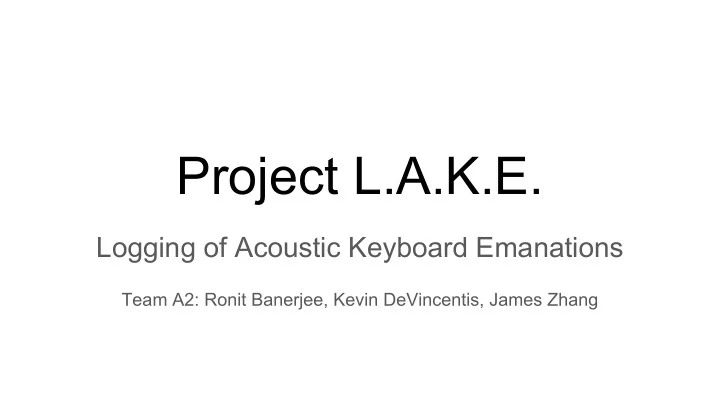

Project L.A.K.E. Logging of Acoustic Keyboard Emanations Team A2: Ronit Banerjee, Kevin DeVincentis, James Zhang
Using Sound as a Keylogger ● Determine what a person is typing based on the sound of their keystrokes ● Exploit small differences in key sounds ● Ultimate goal: determine passwords from recordings of typing
Practicality ● Can be used in real world scenario ○ E.g. Libraries ● Custom low-power, small wireless sensor package. ● Learning process on a laptop done in 60 mins. ● Device has a long battery life, allowing us to collect more data
Requirements Physical ● Last for 24 hours (4 hours active) on a common 2000 mAh battery pack ● PCB size: 2 inches x 3 inches ● Device placed within 6 inches of keyboard Computation ● Training data: 10 minutes of recorded English typing ● Training time: 60 minutes on modern laptop ● No English language model applied on output Target accuracy ● 80% of 10-character passwords can be generated in fewer than 75 attempts ○ Keyboard Acoustic Emanations Revisited - Zhuang et al.
● Three Main Components ○ Embedded Sensor Package ○ Signal Processing ○ Machine Learning
Approach: Building a Sensor Package ● Low-power sensor suite ● Use EC/MEMS microphone and accelerometer ● Custom hardware allows for more control over sensors ● ESP32 microcontroller for wireless communication ● Ultra low power wakeup microphone like the Vesper VM1010
Approach: Signal Processing ● Noise Reduction ● 3 distinct sounds of a keystroke ● Feature selection: ○ Frequency response ○ Time between keystrokes ○ Amplitude
Approach: Machine Learning Techniques ● Cluster keystrokes into different classes based on acoustic features ● Apply language model to match clusters to keys ○ English Language Statistics ○ HMM ● Apply cluster classification to guess typed letter ● For English text, apply language model again to improve accuracy
Challenges ● Building a pcb in the form factor required ● Reducing noise in recorded audio ● Accurately seperating keystrokes without loss ● Determining features of keystrokes to learn on ● Learning less common letters like q, z, and x
Metrics and Testing ● Metric: Power consumption of sensor package Test: ○ Measure current consumption in active/sleep modes ○ Test: Stress test in real environment (HH1303) for 24 hours ● Metric: Accuracy ○ Individual character/word accuracy ○ Password accuracy (both 75 and 3 tries) Test: ○ Measure occurrence of misclassification in typed English text in test set ○ For each training set, generate a set of random 10-character passwords ○ Measure occurrence of correct password in top 75 guesses
Recommend
More recommend